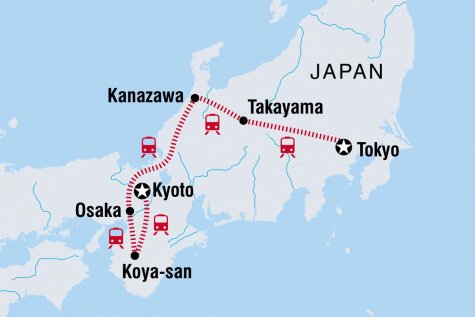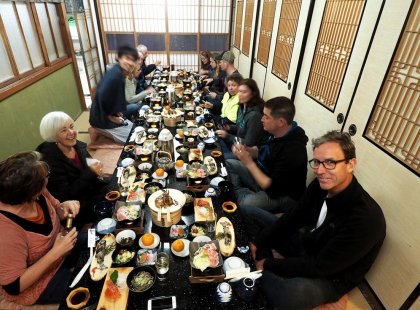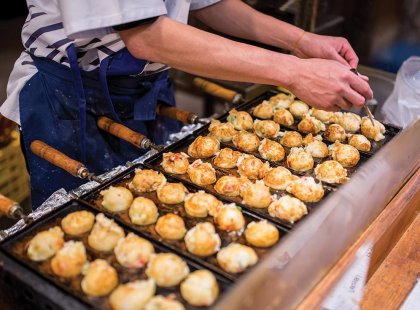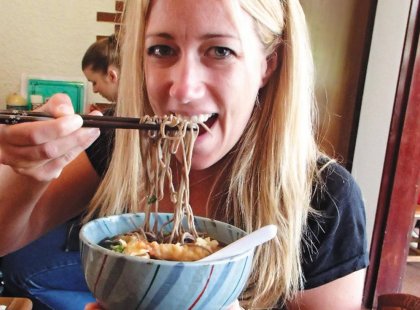Spoil the senses on a culinary tour from Tokyo to Kyoto. Pack your chopsticks and celebrate thousands of years of food artistry by diving into one of the world’s most elegant, eclectic and harmonious cuisines. Spend your time spent seeing the sights and scouting out prized eating and drinking spots. Watch yakitori sizzling in front of you in a Tokyo backstreet, eat fresh-off-the-boat sashimi and learn to make soba noodles in a hands-on cooking class. Glimpse a geisha drifting through the alleyways of Gion while in Kyoto and experience a charming obanzai dinner of Kyoto-style home-cooked dishes. Stay in a traditional ryokan in Takayama and eat vegetarian shojin ryori (monastic fare) with monks in Koya-san. If you're looking for a trip that tantalises the tastebuds as well as sates a sense of adventure, this Japan Real Food Adventure ticks all the boxes.
-
Duration: 12 daysService level: Standard
-
Starts in: Kanto HeiyaPhysical Grading: Average
-
Ages: 15+

Itinerary
Start place: Kanto Heiya
Then join your leader for a Welcome dinner at a local Asakusa or Ueno restaurant representative of this traditional part of Tokyo - perhaps some perfectly grilled yakitori (chicken and vegetable skewers) washed down with some local beer or a drop of fine sake. For those not suffering jet-lag, consider taking a short train ride to Ginza and Yurakucho to enjoy the night-time ambiance or relax over a cocktail at one of the shiny new Marunouchi buildings near Tokyo station.
Later, learn the art of creating soba, Japan’s famed buckwheat noodle, in a hands-on cooking class. Slurp up your creations for lunch. This afternoon you’ll take some time sightseeing in the historic Asakusa area. This is one of the older and more traditional parts of Tokyo, and is often called the temple district. Here you’ll stop by Senso-ji, the city’s oldest temple – founded almost 1,400 years ago when Tokyo was nothing more than a fishing village. If you’ve got a sweet tooth then Asakusa is also a great place to satisfy a sugar craving – try fried sweet potatoes tossed in sugar, soy sauce and mirin, or sweet red bean paste sandwiched between baked pancake batter. Afterwards, consider heading to Tsukishima to enjoy one of Tokyo's most popular dishes – monjayaki. a type of savoury pancake. Or for those who wish to explore Tokyo's urban heart, head to the mega-hub of Shinjuku and the famed Golden Gai area for its crowded alleys of izakaya, tiny bars and jazz haunts. You could also check out the observation deck of the Metropolitan Government Building for a stunning night view of the city's skyline.
For the next two evenings you will stay in a traditional ryokan (Japanese inn). Rooms are equipped with thin futon mattresses that are spread on tatami mats for a comfortable night's sleep. Over the next two evenings you will dine on regional Takayama delicacies.
Back in Takayama for dinner, you'll be able to sample some more of the town's iconic dishes.
Notes: There are no western bathing facilities at the monastery. Instead, bathing is done in a traditional public bath. This is a two-step process. The first step is to thoroughly clean yourself, followed by a cleansing soak in a hot bath. Onsen are communal bathing areas and it is not permitted to wear bathing suits. While this can seem intimidating at first, it is a quintessential Japanese experience and often a highlight for travellers in Japan. For those who are more sensitive about public bathing, your leader can suggest times of day when you are likely to have more privacy.
Or perhaps try some hamo eel - a quintessential Kyoto dish in the warmer months. An unknown chef in Kyoto first transformed the eel from 'inedible' to the star ingredient with the invention of a heavy knife that could separate the flesh from the bones. In the cooler months you might try some yuba cuisine or a hotpot of yudofu, using Kyoto's famed smooth flavoured tofu, perfected over centuries by Buddhist monks. Your leader is always there to help you choose!
Inclusions
Included
- Welcome Dinner at a local restaurant
- Tokyo - Asakusa guided walk & Sensoji Temple
- Tokyo - Soba-noodle making class
- Tokyo - Tsukiji Outer Market & Sushi Tasting
- Takayama - Hida Folk Village
- Hida-Furukawa - Sake Brewery visit
- Takayama - Morning Market visit
- Kanazawa - Orientation Walk
- Kanazawa - Wagashi (sweet) making demonstration
- Kanazawa - Omicho Market
- Osaka - Street Food Tour
- Koya-san - Okuno-in Mausoleum walk
- Kyoto - Gion District walk
- Kyoto - Nishiki Market walk
- Kyoto - Orientation Walk
- Kyoto - Obanzai cooking class
- Kyoto - Kyoto-style Final Night Dinner
- Kyoto - Tea Farm visit
-
Transport
Bus, Train, Bullet train -
Accommodation
Hotel (8 nights), Ryokan (2 nights), Monastery (1 night)






